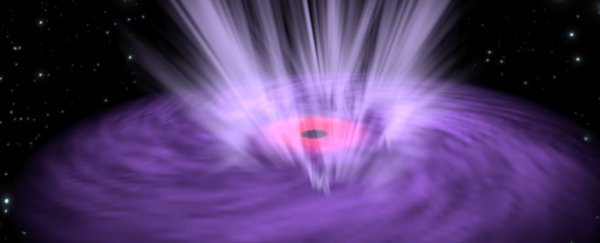Scientists have made the most detailed observations ever of the incredibly fast and strong 'winds' that gust from supermassive black holes, and measured the rapidly changing temperatures in these hot gases for the very first time.
New readings show that the wind blasts emanating from the black hole at the centre of a galaxy called IRAS 13224–3809 are some of the fastest ever recorded – but the biggest surprise here is that these gas flows can dramatically flux in temperature within hours.
"We know that supermassive black holes affect the environment of their host galaxies, and powerful winds arising from near the black hole may be one means for them to do so," says astrophysicist Fiona Harrison from Caltech.
"The rapid variability, observed for the first time, is providing clues as to how these winds form and how much energy they may carry out into the galaxy."
Thanks to new observations with NASA's NuSTAR and the European Space Agency's (ESA) XMM-Newton telescopes, scientists found that wind blasts at the heart of IRAS 13224–3809 can travel at up to 0.24 times the speed of light – or around 71,000 km/s (44,000 mps) to you and me.
That puts these gas flows – also called ultra-fast outflows – in the fastest 5 percent of space wind blasts ever detected.
So where do these space winds come from? Unlike the air movements we have here on Earth, ultra-fast outflows are something like a severe case of cosmic indigestion.
Supermassive black holes lie at the centre of most galaxies, and are surrounded by an accretion disk of gas and dust from which they feed.
If black holes consume too much of this matter too quickly, they 'burp' out this ultra-fast wind, which is so powerful, it's thought to suppress the ability of stars to form throughout the galaxy.
"Although we have seen these outflows before, this observation was the first time we were able to see the launching of the gases being connected with changes in the luminosity of black holes," says astronomer Erin Kara from the University of Maryland.
What made that detection possible was XMM-Newton focussing on the black hole for 17 days in a row, with NuSTAR observing it for six days.
That long period of gazing at IRAS 13224–3809 let the scientists observe temperature changes in the wind blasts occurring dramatically faster than what researchers had previously detected.
"We often only have one observation of a particular object, then several months or even years later we observe it again and see if there's been a change," says researcher Michael Parker from the University of Cambridge in the UK.
"Thanks to this long observation campaign, we observed changes in the winds on a timescale of less than an hour for the first time."
The team was able to measure the temperature of the gas flows by measuring X-rays emanating from the black hole.
As these X-rays interact with elements such as iron and magnesium in the wind, they heat the wind up to extremely high temperatures – millions of degrees Celsius – to the point where the winds can't absorb any more X-rays.
The winds then cool, and as they do, the matter within them regains its ability to absorb X-rays, and this whole process happens a lot faster than anybody thought.
The exact temperatures haven't yet been nailed down, since the temperature variation is a hypothesis based on the elements in the wind becoming incapable of absorbing any more X-rays.
But it's our best evidence yet that this phenomenon produces massive and rapid temperature swings.
"The chemical fingerprints of the wind changed with the strength of the X-rays in less than an hour, hundreds of times faster than ever seen before," says the principal investigator of the project, Andrew Fabian from the University of Cambridge.
"It allows us to link the X-ray emission arising from the infalling material into the black hole, to the variability of the outflowing wind farther away."
Now that we know about this link between what black stars consume and the variations in the cosmic burps they generate, it will help us understand more about the impact of these super-powerful winds on the galactic neighbourhood – and the poor, would-be stars – around them.
"Black hole winds are one of the mechanisms for feedback, where the energy coming out from the black hole regulates the growth of the host galaxy," says Parker.
"Understanding these winds is crucial to understanding how galaxies, including our own, grow."
The findings are reported in Nature.
